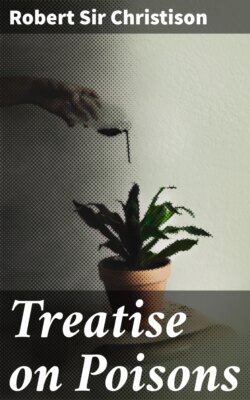Читать книгу Treatise on Poisons - Robert Sir Christison - Страница 34
Section I.—Of the Tests for Hydrochloric Acid.
ОглавлениеLike the other acids, hydrochloric acid occurs in the concentrated shape, in a state of simple dilution, and mixed with various matters, especially from organic kingdoms.
1. Hydrochloric acid, in its concentrated state, is colourless, if pure, but yellowish as usually sold; and it is easily known by the peculiar appearance and odour of its fumes. A convenient additional test, which, however, is not absolutely distinctive, is the formation of white vapour when a rod dipped in it is brought near another dipped in ammonia. If any farther evidence be desired, the strong acid must be diluted with water, and examined by the tests for it in a diluted state.
2. When diluted, it is recognised with facility, first by litmus-paper, and then by the nitrate of silver, which forms with it a dense, white precipitate, the chloride of silver. This is soluble in ammonia, reappears on neutralizing the ammonia by nitric acid, and is not redissolved by a large excess of nitric acid, even aided by heat. Its permanence under an excess of nitric acid distinguishes it from every other silver salt, but the cyanide; which again is known by disappearing when boiled with a large excess of the acid.
3. In the last edition of this work I proposed for the detection of hydrochloric acid in compound organic mixtures a process, to which Professor Orfila has since made an important addition,[312] and which the investigations of that toxicologist, as well as my own, lead me to suppose superior to any other yet suggested, although it is not entirely free from objection. This process divides itself into two, according as the subject of analysis is acid or neutral; but in the latter case its indications are of dubious import.
a. If the matter to be examined be acid, boil it with water if necessary, filter, and distil it with a gentle heat till the residue acquire the consistence of a very thin syrup. Subject the distilled liquor to the tests for diluted hydrochloric acid. It will seldom be found there, however, because it is apt to be retained by the co-existence of organic matter. If it be not found, add to the thin extract in the retort a slight excess of a strong solution of tannin, filter, and distil the filtered liquid by means of a hot bath of solution of hydrochlorate of lime (consisting of two parts of crystallized salt and one of water,)—taking care that the temperature of the bath never exceeds 240°; and stop the distillation just before the residuum becomes dry. Examine now the distilled liquor with the tests for diluted hydrochloric acid.
Hydrochloric acid has a tendency to adhere with obstinacy to organic matters, especially when these are abundant; and therefore Orfila properly proposes to remove organic principles as far as possible by precipitating them with solution of tannin. I have found, as he did, that the acid may be obtained by distillation after this measure, when it could not be obtained previously.—Orfila objects to the process however that hydrochlorate of ammonia will pass over in the distillation. But I have not found this to be the fact, when the temperature did not rise above 240°; which in his experiments seem to have been considerably exceeded.—A more important fallacy is, that hydrochloric acid will be indicated by the process in a mixture which contains both a neutral chloride, such as common salt, and sulphuric acid. This fallacy can only be obviated by ascertaining that sulphuric acid is not present.—But the most important fallacy of all is, that free hydrochloric acid constitutes an essential part of the gastric juice, and an ingredient of the secretions of the stomach in various states of disordered digestion.[313] It is not easy to see how this fallacy can be obviated, unless the acid be obtained in large quantity; nor am I prepared to say what quantity would justify the conclusion, that the acid had been derived from an external source. Dr. Prout once found between four and five grains of pure acid in sixteen ounces of the fluid of water-brash.[314] The quantity of hydrochloric acid is to be known by drying, heating and weighing the chloride of silver thrown down in the distilled fluid by nitrate of silver, and allowing 100 parts of concentrated commercial acid for 145 of chloride.
b. When the mixture is neutral, hydrochloric acid can be no longer detected in it without the aid of sulphuric acid to decompose the chloride that has been formed. This should be added to the filtered fluid obtained after organic matter has been separated by solution of tannin. Hydrochloric acid will then distil over.—It is seldom however that the discovery of the acid in this way will warrant the conclusion, that it had ever existed free in the mixture whence it is obtained. For it may have proceeded from chlorides contained in the subject of analysis from the first, more especially chloride of sodium, which exists in small quantity in all animal fluids and solids, and more largely in many articles of food and drink. The only circumstance indeed in which the detection of hydrochloric acid by decomposition with sulphuric acid will yield any evidence,—and even then the evidence will only be presumptive,—is when it is known that an earth or alkali was given as an antidote, and when the alkali or earth which was used is found in the suspected substance.
